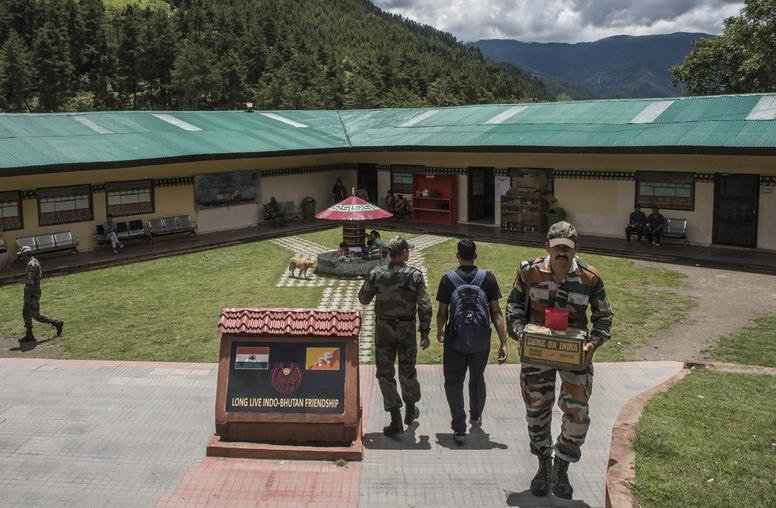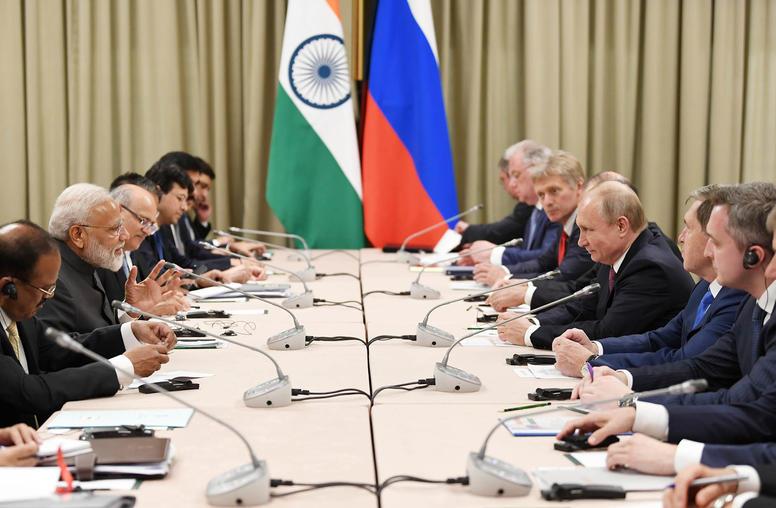Vikram Singh on President Trump’s Trip to India
The visit did not yield a bilateral trade agreement, as many hoped it would. But USIP’s Vikram Singh says that despite the trade impasse, the trip did deliver defense and energy deals and reinforced “the symbolism of this partnership continuing to grow basically as it has for the entire 21st century.”
On Peace is a weekly podcast sponsored by USIP and Sirius XM POTUS Ch. 124. Each week, USIP experts tackle the latest foreign policy issues from around the world.
Transcript
Tim Farley: President Donald Trump addressed a crowd of over 100,000 in India the day before yesterday:
(Audio clip)
Tim Farley: Now what does this mean concretely? Let's get some analysis. Vikram Singh is senior advisor of the Asia Center at the United States Institute of Peace. We should note on his resume, he was deputy assistant secretary of defense for South and Southeast Asia from 2012 to 2014, also deputy special Representative for Afghanistan and Pakistan at the State Department at one time, and is the recipient of the Defense Medal for Distinguished Civilian Service and the Department of State Superior Honor Award, a couple of awards coming his way. He is joining us now, Vikram Singh, who is tweeting @VJS_Policy. Vikram Singh, welcome. Welcome back, I should say, to POTUS.
Vikram Singh: Hey great, glad to be with you.
Tim Farley: What was the mission of the President, aside from being able to stand in front of 100,000+ people and say wonderful things about Narendra Modi, the prime minister. What else did he hope to come away with—were there deliverables on this trip?
Vikram Singh: Well, first of all, I think that that great big rally is the kind of thing that both President Trump and Prime Minister Modi really relish. It's signature to both of their politics. And that was actually a key objective of this trip, was to have this public demonstration of the partnership, and the friendship, and show both of them off and repay ... The Indians got to repay Donald Trump for the Howdy Modi event, which was a similar huge rally that Prime Minister Modi did last year in Houston in front of 50,000 people.
Vikram Singh: So it's become a signature thing in their relationship. But the main deliverables were defense deals, some energy deals, and the symbolism of this partnership continuing to grow, basically as it has for the entire 21st century, for the last 20 years across administrations. Those defense deals were a little over $3 billion. There's increases in exports in natural gas from the United States to India, but they didn't get one thing done that people had expected and hoped for, which was a first step towards a bilateral trade agreement, which is really of the big prize in U.S.-India relations, at least on the economic front.
Tim Farley: Let's talk about something else the president raised in his speech the other day:
(Audio clip) We just hope, and I said I'll help. I'll do whatever I have to do, if I can do that, because my relationship with both gentlemen is so good. But there has been difficulty in Pakistan, and we're seeing what we can do about it. Anything I can do to mediate, anything I can do to help, I would do.
Tim Farley: He had mentioned it in the speech, but that was during the press conference that he held yesterday. Is this an actual thing that might happen?
Vikram Singh: I think it's really unlikely. I don't think there's any harm with the President of the United States saying he wants to offer good offices between any countries that have conflict. And there's no doubt that India and Pakistan is a dynamics that would lead lots of people to worry. Countries with relations really at a bad point, the have fought several wars in the past, and that are both nuclear powers. And so I think that's fine. I think the fact is that the Indians have never welcomed third-party assistance in their dispute with Pakistan, which they see as purely bilateral issues. The Pakistanis, in contrast, have often thought that outside mediation would probably serve their interests, so they've been more interested in it. I suspect that unless this were to be something that both leaders came to the United States or another third party and asked for, "Hey, would you help us broker something," I suspect that it's just a perfectly nice thing to say, but it's not going to have any impact on the tensions between those two countries.
Tim Farley: Vikram J. Singh is with us, senior advisor of the Asia Center at the United States Institute of Peace. I thought it was interesting, we were carrying the press briefing yesterday, the press conference the president was having. And the U.S. press questions included things about his back and forth with Supreme Court Justices like Sonia Sotomayor and the Russian interference. But the questions from the local domestic press in India, I'm thinking, and BBC was in there, had to do with the H-1B visas on immigration. Another question on that, with we just talked about with Pakistan, and another one on the Afghanistan situation. And I'm wondering, so what would be the role of India playing in an agreement with Afghanistan and the Taliban moving forward?
Vikram Singh: Yeah, so this is actually really interesting, because in terms of support for Afghanistan, the United States and India have been extraordinarily closely aligned, India's biggest foreign aid recipient is Afghanistan, something over $3 billion, which is rather substantial for a country like India that's not in the global foreign aid business in a big way. And India is an extremely strong supporter of the government in Afghanistan, whether it was Hamid Karzai's government, or the current government of Ashraf Ghani, the Indians have basically said, "We stand with the Afghan government," and have been very doubtful about getting any kind of good deal with the Taliban. So they're nervous about the U.S. negotiations with the Taliban, and the potential for this deal, if it fails, to lead to a stronger Taliban control of Afghanistan, which the Indians would see is really against their interests.
Vikram Singh: On the other hand, they support the Afghan people's desire for peace. I think the role of the Indians could best play is being a voice in support of maintaining the progress that Afghanistan has seen, girls being able to go to school, modernizing the economy, trying to move forward, and get out of the long, painful 40 years of war that that country has had. So I think the Indians can play a positive role, and I hope that that's what they'll do. They’ll be a skeptical but supportive partner in trying to help Afghanistan get to a sustainable peace.
Tim Farley: The last question: the President and the first family, I guess, his daughter was there along with Jared Kushner visiting Taj Mahal. There was pomp. There was pageantry, the 100,000 people at the rally, yet in the wake of the President's visit today, we hear the report that at least 20 people were killed, 189 injured in three days of fighting in New Delhi, coinciding with the President's visit to India. Are they connected and/or what does it say about Mr. Modi's popularity or lack thereof in India?
Vikram Singh: Well, I mean this is really important, and hearts go out to victims of the violence, which have included a police officer, a lot of innocent shopkeepers. India has a long history of communal violence, primarily between Hindus and Muslims. With a very large Muslim minority, almost 200 million Muslim citizens of India. That tension hearkens back to the separation of India and Pakistan into a Hindu majority India, and a Muslim state in Pakistan at independence. And it erupts fairly regularly. So there's a long history of intercommunal violence. The timing is really terrible. It doesn't look at all good to have all the talk of religious harmony, and human rights in this really high profile state visit, and then to have communal violence descending on New Delhi, the capital of India.
Vikram Singh: And I think it's a test for this government, whether they can tamp that down through engagement with the communities. The one thing that's been really worrying has been, there have been political figures in India who I think people feel had been stoking, rather than tamping down, the hostile sentiments between the communities. And this all comes in the wake of some controversial legislation passed in India that favors religious minorities from neighboring countries coming in as refugees and gaining citizenship if they're not Muslim, so Hindus, or Jains, or Christians from neighboring countries now have a faster track to citizenship, and concerns that there might be a trend towards two classes of citizenship in India. The government assures everyone that that's not their intention, but it's led to a lot of peaceful protests all across the country for weeks, well over a month now. And here we're seeing those peaceful protests get turned violent, and hopefully it's something that can be addressed quickly, and India can get back on track of being a diverse and peaceful democracy.
Tim Farley: Vikram J. Singh—thank you for taking us beyond the headlines, Vikram. Thanks for being on POTUS today.
Vikram Singh: Yeah, it was a pleasure, thanks.
Tim Farley: Vikram J. Singh is senior advisor of the Asia Center for the United States Institute of Peace. Longtime experience, as we pointed out in the beginning, handling and discussing some of these issues, and specifically about the President's visit to India, and what we can take away from what the President took away from India, tweeting @VJS_Policy.



